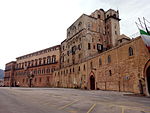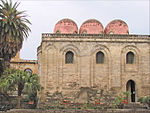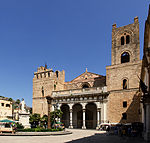Arab-Norman Palermo and the cathedrals of Cefalù and Monreale
| Arab-Norman Palermo and the cathedrals of Cefalù and Monreale | |
|---|---|
|
UNESCO world heritage |
|

|
|
| National territory: |
|
| Type: | Culture |
| Criteria : | (ii) (vi) |
| Reference No .: | 1487 |
| UNESCO region : | Europe and North America |
| History of enrollment | |
| Enrollment: | 2015 ( session 39 ) |
Arab-Norman Palermo and the cathedrals of Cefalù and Monreale is one of the UNESCO -listed site of world cultural heritage in the Italian region of Sicily .
background
Sicily has been settled and ruled by different peoples in the course of its history . In antiquity it was largely colonized by the Greeks , but Palermo was Phoenician - Carthaginian , and then fell under the Roman Empire . After its division, Sicily came under Byzantine rule . In the 9th century the Arabs conquered the island and in the 11th century the Norman conquest followed . The Normans , who established their own kingdom in Sicily, formed the upper class, while the island's population was largely of Greek or Arab origin.
From the mixture of these cultures, a special art style developed in Sicily, which is now called Norman-Arabic-Byzantine art . This art style is particularly striking in architecture . For example, the compact exterior of Monreale Cathedral corresponds to the Norman architecture in the Romanesque style. Facade details such as B. the overlapping blind arches, which can be seen above the porch on the facade and particularly impressively with inlay work on the rear apse, are Arabic style elements. Inside, the gold ground mosaics on the walls show the Byzantine influence.
registration
Arab-Norman Palermo and the cathedrals of Cefalù and Monreale were inscribed on the UNESCO World Heritage List in 2015 following a decision of the 39th session of the World Heritage Committee . In the summary of the resolution it says about the structures:
Together they are an excellent example of socio-cultural syncretism between Western, Islamic and Byzantine culture. Based on novel concepts of space, structure and decoration, this exchange led to an architectural and artistic expression that spread widely throughout the Mediterranean. ... Each [building] shows important aspects of the multicultural Western-Islamic-Byzantine syncretism that shaped the Norman Kingdom of Sicily in the 12th century. The innovative redesign of architectural forms, structures and materials and their artistic, decorative and iconographic processing - most noticeably the rich and extensive Tessera mosaics, floors in opus-sectile technique, inlays , sculptural elements , paintings and fittings - celebrate the fruitful coexistence of People of different origins.
The entry was made on the basis of criteria (ii) and (iv).
(ii): Arab-Norman Palermo and the cathedrals of Cefalù and Monreale testify to a special political and cultural situation, which was characterized by the fruitful coexistence of people of different origins (Muslim, Byzantine, Latin, Jewish, Lombard and French). This exchange creates a conscious and unique combination of elements derived from the architectural and artistic techniques of Byzantine, Islamic and Western traditions. This new style contributed to the developments in the architecture of the Tyrrhenian side of southern Italy and spread widely in the medieval Mediterranean.
(iv): Arab-Norman Palermo and the cathedrals of Cefalù and Monreale is an excellent example of a stylistic synthesis that created new spatial, structural and decorative concepts through the innovative and coherent redesign of elements from different cultures.
Individual structures
The individual structures that are part of the world cultural heritage are predominantly on the north side of the island of Sicily. Two castles , four churches , including the cathedral , and a bridge are in Palermo , which was the capital of the Norman Kingdom of Sicily . Two other cathedrals are located in cities in Sicily that were important bishoprics in the Middle Ages . Specifically, the Arab-Norman World Heritage Site Palermo and the cathedrals of Cefalù and Monreale include the following nine structures:
| Building | Type | location | Remarks | image |
|---|---|---|---|---|
| Palazzo dei Normanni (or Palazzo Reale) with the Cappella Palatina | lock |
Palermo's Piazza del Parlamento location |
Summer residence of the Emir of Palermo from the 9th century, converted by Roger II into his seat of government, seat of the Norman kings of Sicily (hence the name Palazzo dei Normanni = Norman Palace), currently seat of the Parliament of Sicily . |
 ( more pictures ) ( more pictures )
|
| Castle chapel |
Palermo in the Palazzo dei Normanni location |
Erected from 1132 to 1140 under King Roger II as the court chapel of the Palazzo dei Normanni (Palazzo Reale), consecrated in 1140, floor adorned with marble and porphyry , wooden ceiling decorated with Arabic carving, gold mosaics on the walls and in the dome . |
 ( more pictures ) ( more pictures )
|
|
| Castello della Zisa | lock |
Palermo Piazza Zisa location |
Begun in 1165 under Wilhelm I and completed in 1167 under his son Wilhelm II , cube-shaped building with three floors, today the seat of the Museum of Islamic Art . |
 ( more pictures ) ( more pictures )
|
| Palermo Cathedral | church |
Palermo Corso Vittorio Emanuele location |
Cathedral of the Archdiocese of Palermo , built in 1184/1185 in place of a previous building badly damaged by an earthquake in 1169, portico from 1465 in the Catalan late Gothic style , 1781 to 1801 remodeling of the exterior and interior and installation of the dome. |
 ( more pictures ) ( more pictures )
|
| San Giovanni degli Eremiti | church |
Palermo Via dei Benedettini location |
Built by Roger II shortly after his confirmation as King of Sicily in 1130 on the site of a previous Arab building as part of the oldest Latin monastery in Palermo and completed in 1143. |
 ( more pictures ) ( more pictures )
|
| Santa Maria dell'Ammiraglio | church |
Palermo Piazza Bellini location |
from 1143 under George of Antioch , the Ammiratus of King Rogers II , built as his private church, baroque facade from the 17th century, since 1943 seat of the parish of San Nicolò dei Greci with Byzantine rite and concathedral of the Eparchy Piana degli Albanesi . |
 ( more pictures ) ( more pictures )
|
| San Cataldo | church |
Palermo Piazza Bellini location |
1154–1160 under Maio von Bari , the Ammiratus of King Wilhelm I , built as his private church, one of the last churches in Sicily in the Arab-Norman style |
 ( more pictures ) ( more pictures )
|
| Ponte dell'Ammiraglio | bridge |
Palermo Corso dei Mille location |
Bridge with twelve pointed oval arches, built after 1132 under George of Antioch , the Ammiratus of King Rogers II , originally spanned the Oreto River . |
 ( more pictures ) ( more pictures )
|
| Monreale Cathedral | church |
Monreale Piazza Vittorio Emanuele location |
Cathedral of the Archdiocese of Monreale , built from 1172 to 1176 under King Wilhelm II , walls covered with Byzantine gold-ground mosaics . |
 ( more pictures ) ( more pictures )
|
| Cefalu Cathedral | church |
Cefalù Piazza Duomo location |
Cathedral of the Diocese of Cefalu 1131-1140 under King, Roger II. Built |
 ( more pictures ) ( more pictures )
|
Web links
- Arab-Norman Palermo and the cathedrals of Cefalù and Monreale on the UNESCO World Heritage Center website ( English and French ).
- Palermo Arabo-normanna e le Cattedrali di Cefalù e Monreale , website of the Fondazione Patrimonio UNESCO Sicilia (Italian and English )
Individual evidence
- ↑ a b World Heritage Committee: Decision: 39 COM 8B.28. July 8, 2015, accessed August 27, 2016 .
